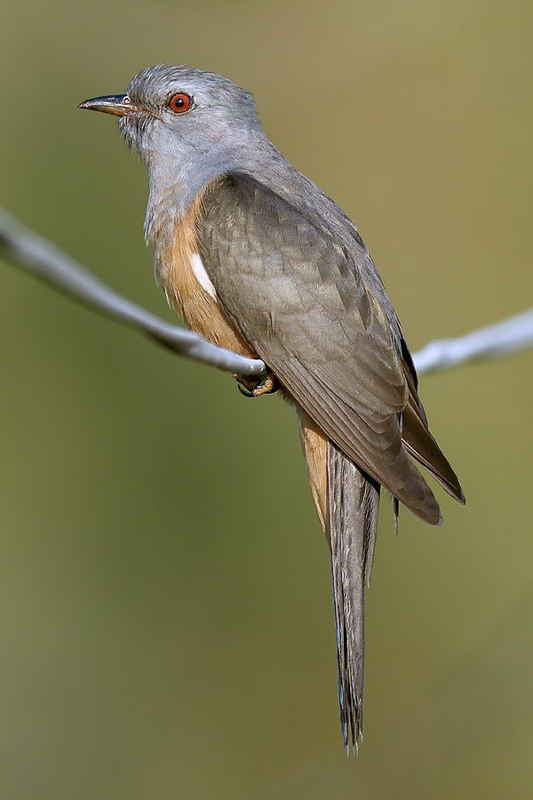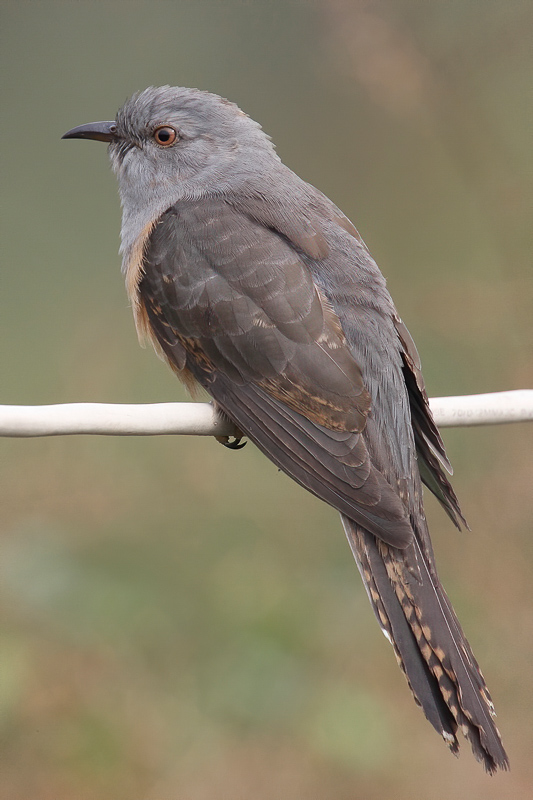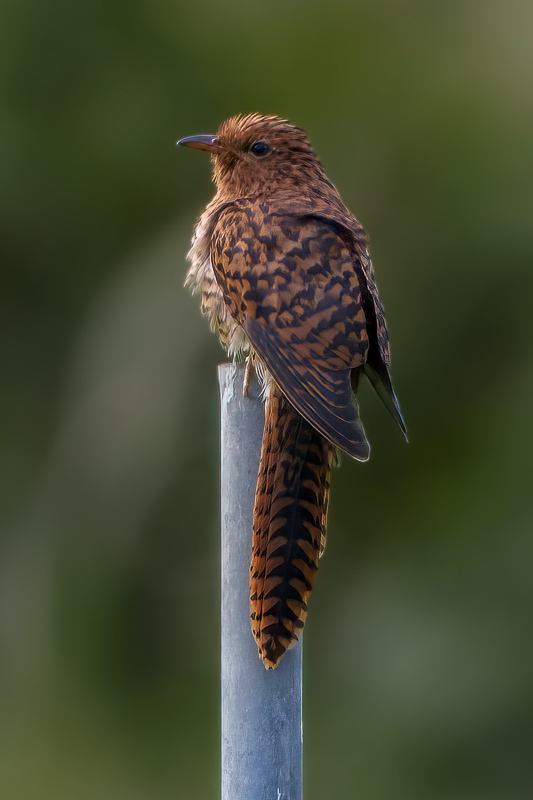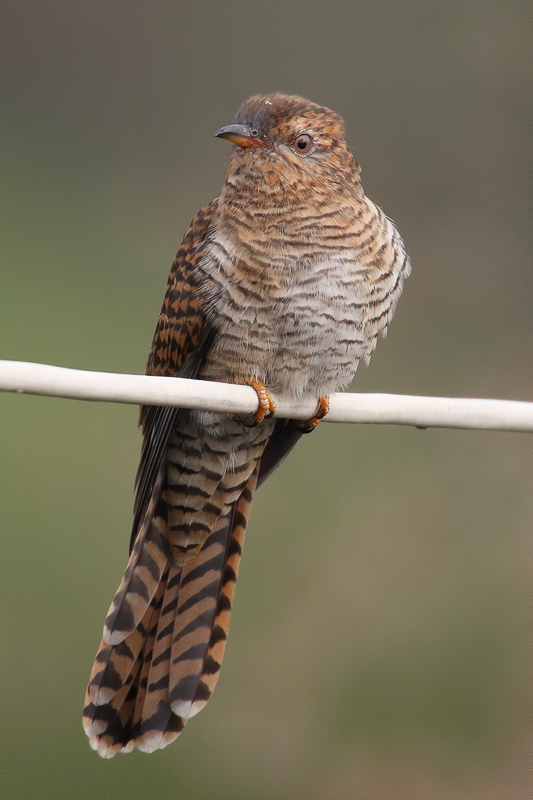Plaintive Cuckoo Cacomantis merulinus 八聲杜鵑
Category I. Locally fairly common summer visitor, scarce passage migrant and winter visitor, with some individuals likely to be resident. Occurs in lowland rural areas of mixed habitats, often in agricultural areas.
IDENTIFICATION

Dec. 2007, Michelle and Peter Wong.
18-23 cm. A small, slim cuckoo with a long graduated tail tipped white on the underside. Adults have a grey hood extending to the upper breast, greyish-brown mantle, wings and tail, and unmarked orange-buff underparts.

Jan. 2008, Martin Hale.
On this first-winter male the grey is duller and brown-barred juvenile feathers are visible in the wing coverts and tertials.

Oct. 2022, Robert Hackel.
On rufous-morph birds (females only), the upperparts are dark rufous-brown barred black. Juveniles resemble brown birds, but are streaked on the crown, neck, mantle and breast. Iris reddish, bill black with yellow base, legs and feet yellow.
The grey morph of the adult female is similar to the male but has abdomen barred whitish and tail feathers more barred (Erritzøe et al. 2012).

Jan. 2008, Martin Hale.
The underparts of rufous morph birds are whitish with narrow brown bars.
VOCALISATIONS
Adults on territory usually utter a plaintive whistle consisting of four or five drawn-out notes followed by four or five short rapid notes that descend in pitch and fade at the end: ‘pi pi pi pi pihihihu.’
A less frequent vocalisation is a repeated ‘pee pu-tu-ee’ introduced by several drawn-out ‘pee’ notes; the whole rises in tone and becomes more excited.
DISTRIBUTION & HABITAT PREFERENCE
Plaintive Cuckoo occurs in widespread lowland areas of the northern New Territories, locally elsewhere, including Kowloon, HK and Lantau Islands, and occasionally on smaller islands. Among particularly favoured sites that host records in all seasons, are Long Valley / Ho Sheung Heung, Mai Po, nearby fish pond areas such as San Tin, Lam Tsuen Valley and, formerly, Kam Tin, all of which are set in rural landscapes near villages and characterised by relatively large open areas of agricultural land, fish ponds or marshes fringed by light woodland and/or fung shui woods. Other habitats utilised in the breeding season and occasionally on passage include urban parks and gardens. Though occasionally noted at the edge of forest or shrubland, it is not found deep in forest or in extensive areas of contiguous shrubland.
OCCURRENCE
Plaintive Cuckoo has been recorded in all months of the year. The pattern of occurrence in Figure 1 reflects the fact it is vocal mainly from February to July, especially March-May, occasionally also January and August, but rarely or never in other months. Numbers detected are very low in January (less than 3% of the total) and only slightly higher in February, but rapidly rise to peak between the third week of March and the second week of May (with the three months March-May together accounting for 63% of the total), before falling through June (8%) and July (4.5%) to reach a late-summer low in August (3%), after which there is a slight but distinct increase in September-October, indicating the presence of autumn migrants at this time, before numbers drop to very low levels again in November-December (3% and 2.5%, respectively). The seasonal and spatial pattern of records suggest that there is a small resident population whose numbers are augmented first by summer visitors, which arrive in March or April and depart again by August, and later by autumn migrants.
Most records are of one or two birds. Highest single-site counts in the breeding season are seven at Kam Tin on 12 June 2007, five at Mai Po on 3 April 2017, and five in the Lam Tsuen Valley on 13 April 2019. Highest counts in autumn are seven at Ho Sheung Heung on 24 September 1993 and five at Long Valley on 17 November 2007. With the exception of six on the former marshes at Ha Tsuen on 11 January 1987, there are no winter records involving more than three birds.
The first records explicitly referring to HK were reported by Jones (1908) who stated that this cuckoo arrived in March and departed in September, could frequently be heard uttering its song during the summer months and parasitised the nests of Common Tailorbird. The only localities mentioned from this time to the early 1940s were on HK Island (Vaughan & Jones 1913, Herklots 1940, 1941). The first reports from the New Territories were from Fanling in May 1953 (Dove & Goodhart 1955) and Ping Shan in January 1957 (Walker 1958), the latter also the first record in winter. By the 1980s, it was regarded as a fairly common and widespread summer visitor with regular winter records (Chalmers 1986). In the 1990s a distributional decline on HK Island and a suspected decline in overall numbers led to it being considered an uncommon summer visitor with occasional autumn and winter records (Carey et al. 2001).
BEHAVIOUR, FORAGING & DIET
Apparently territorial birds may perch openly on wires and exposed branches or in dense foliage near the top of smaller trees to sing, especially from March to May when they may be heard day or night and in fine weather or rain. The only food item recorded in HK is caterpillars. The flight is rapid, often terminating in a shallow swoop to a perch.
BREEDING
An egg found in the nest of a Common Tailorbird on 25 April 1908 is described in some detail and illustrated in an accompanying plate by Vaughan and Jones (1913). Single recently-fledged juveniles, nearly all fed or closely attended by Common Tailorbirds, have been noted since then on at least 10 occasions between 10 May and 10 October; the span of dates indicates a long breeding season in HK.
RANGE & SYSTEMATICS
Widely distributed from northeast India to south China and south through southeast Asia and the Philippines to Sumatra, Borneo, Java, Bali and Sulawesi (Payne 1997, Payne and Kirwan 2020). Of four subspecies recognised, querulus breeds from the east Himalayas to south China, Indochina and parts of the Malay Peninsula, and in China is a summer visitor to widespread areas south of the Yangtze north to southern Shaanxi and southern Henan, and resident in lowland areas of coastal provinces, including Hainan.
CONSERVATION STATUS
IUCN: Least Concern. Population trend stable.
Figure 1.

Dove, R. S. and Goodhart, H. J. (1955). Field observations from the Colony of Hong Kong. Ibis 97: 311-340.
Erritzøe, J., C. F. Mann, F. P. Brammer and R. A. Fuller (2012). Cuckoos of the World. Christopher Helm, London.
Herklots, G. A. C. (1940). Birds of my garden. Hong Kong Naturalist 10: 79-83.
Herklots, G. A. C. (1941). Ornithology. Migrants and visitors. Hong Kong Naturalist 10: 227-228.
Herklots, G. A. C. (1953). Hong Kong Birds. South China Morning Post, Hong Kong.
Jones, K. H. (1908). Birds [of Hong Kong]. Pp. 141-143 in: Wright, A. (ed.) Twentieth Century Impressions of Hongkong, Shanghai, and other Treaty Ports of China. Lloyd’s Greater Britain Publishing Co. Ltd., London.
Payne, R. B. (1997). Family Cuculidae (Cuckoos) in del Hoyo, J., Elliot, A. and J. Sargatal. Handbook of the Birds of the World, vol. 4: Sandgrouse to Cuckoos. Lynx Edicions, Barcelona, Spain.
Payne, R. B. and G. M. Kirwan (2020). Plaintive Cuckoo (Cacomantis merulinus), version 1.0. In Birds of the World (J. del Hoyo, A. Elliott, J. Sargatal, D. A. Christie, and E. de Juana, Editors). Cornell Lab of Ornithology, Ithaca, NY, USA. https://doi.org/10.2173/bow.placuc1.01
Walker, F. J. (1958). Field observations on birds in the Colony of Hong Kong. Hong Kong Bird Watching Society, Hong Kong. (duplicated)

